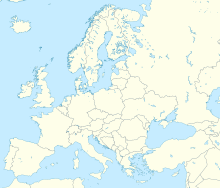Battle of Alhandic
 Kingdom of León
Kingdom of León Caliphate of Córdoba
Caliphate of Córdoba



- v
- t
- e
- 8th century
- Covadonga
- 1st Roncevaux Pass
- Burbia River
- Orbieu River
- Lutos
- Las Babias
- Río Quirós
- Río Nalón
- Oviedo
- 9th century
- 1st Barcelona
- 1st Tortosa
- Pancorbo
- 2nd Roncevaux Pass
- Clavijo
- Albelda
- Guadalacete
- Monte Laturce
- Morcuera
- Polvoraria
- 1st Cellorigo
- 2nd Cellorigo
- 2nd Barcelona
- 10th century
- Day of Zamora
- Pallars and Ribagorza
- 1st San Esteban de Gormaz
- 2nd San Esteban de Gormaz
- Valdejunquera
- 1st Toledo
- Alhandic
- Simancas
- Estercuel
- Torrevicente
- Rueda
- 3rd Barcelona
- 11th century
- Cervera
- Calatañazor
- Torà
- Albesa
- Aqbat al-Bakr
- Graus
- Coimbra
- Barbastro
- Paterna
- Llantada
- Golpejera
- Cabra
- Piedra Pisada
- Morella
- 2nd Toledo
- 1st Zaragoza
- Sagrajas
- Tudela
- Tévar
- 3rd Toledo
- 1st Valencia
- Alcoraz
- Bairén
- Consuegra
- 4th Toledo
- 5th Toledo
- 12th century
- 2nd Valencia
- Mollerussa
- Uclés
- Norwegian raid
- 6th Toledo
- Talavera
- 1st Balearic Islands
- Candespina
- 1st Santarém
- 2nd Balearic Islands
- Martorell
- Coimbra
- 2nd Zaragoza
- Cutanda
- 1st Granada
- 3rd Valencia
- 1st Badajoz
- Fraga
- 1st Coria
- Ourique
- Oreja
- 2nd Coria
- 1st Lisbon
- 1st Montiel
- Almería
- Al-Ludjdj
- 2nd Santarém
- Sacavém
- 2nd Lisbon
- 2nd Tortosa
- 2nd Badajoz
- 3rd Santarém
- Alvor
- 1st Silves
- 2nd Silves
- Tomar
- Alarcos
- 13th century
- Al-Dāmūs
- Las Navas de Tolosa
- Alcácer do Sal
- 1st Jaén
- Peníscola
- Aragonese raid
- Majorca
- 2nd Jaén
- 1st Jerez
- Ares
- Burriana
- Córdoba
- El Puig
- 4th Valencia
- Algarve
- 1st Xàtiva
- 2nd Xàtiva
- Biar
- 3rd Jaén
- 2nd Seville
- Faro
- 2nd Jerez
- Mudéjar revolt
- 3rd Jerez
- 1st Murcia
- Écija
- Martos
- Montesa
- 1st Algeciras
- 2nd Algeciras
- Moclín
- Iznalloz
- 14th century
- 1st Gibraltar
- 3rd Algeciras
- Almería
- 2nd Gibraltar
- Vega de Granada
- Shepherds' Crusade
- Teba
- 3rd Gibraltar
- 4th Gibraltar
- Vega de Pagana
- Getares
- Río Salado
- Estepona
- 4th Algeciras
- 5th Gibraltar
- Linuesa
- Guadix
- 2nd Montiel
- 5th Algeciras
- 2nd Murcia
- 15th century
- Collejares
- Antequera
- 6th Gibraltar
- La Higueruela
- 7th Gibraltar
- Los Alporchones
- 8th Gibraltar
- 9th Gibraltar
- 2nd Granada campaign
- Lucena
- Málaga
- Post-Reconquista Rebellions
- 1st Alpujarras
- 2nd Alpujarras
- North Africa
The Battle of Alhandic (Spanish: Batalla de Alhandic), also known as Battle of Zamora's moat (Batalla del Foso de Zamora), occurred on 5 August 939 in the city of Zamora, Spain.[1] The battle occurred when the troops of the Caliph of Córdoba, Abd al-Rahman III assaulted the walls of Zamora. The defending troops were those loyal to Ramiro II, King of León. The fighting was so bloody that the tide of the battle did not turn until the moat surrounding the city walls was entirely filled with corpses.[2] The troops of Abd al-Rahman won the day and were able to seize the city of Zamora.
This battle should not be confused with the Day of Zamora (Día de Zamora or Jornada del Foso de Zamora) which took place a few decades before in the year 901.
History
Once Abd al-Rahman came to power, he was quick to assert his power and made it his goal to finish the rebels in Al-Andalus. He wanted to consolidate his power base and reestablish the internal order of the Emirate of Córdoba. He decided to go to the border and attack the cities that acted as a protective buffer against the Asturian / Leonese lands to the north. It was on this defensive line that he came upon Zamora.[2] The city was strategically important because it was squarely in the path of march typically used by the Leonese troops. Abd al-Rahman attacked the city on 5 August 939. His strategy was to fill the moat around the city with bodies and debris so that his men could more easily climb the parapets and thus engage the defending soldiers directly. This bloodthirsty strategy lends its name to the battle which is sometimes known as the Batalla del Foso de Zamora (Battle of Zamora's moat).
The final result was a victory for the troops of Abd al-Rahman who sacked the city of Zamora.
See also
- Day of Zamora – Celebrates the battle which took place outside the city walls in 901.
- Zamora, Spain
- Ramiro II of León
- Battle of Simancas
References
- ^ Álvarez Martínez, Ursicino; Ursicinio Álvarez Martínez (1965). Historia General Civil y Eclesiástica de la Provincia de Zamora (primera ed.). Madrid: Editorial Revista de Derecho Privado.
- ^ a b Ferrero Ferrero, Florián (2008). "La configuración urbana de Zamora durante la época románica". STVDIA ZAMORENSIA, Segunda Etapa. VIII. Zamora: 9–44.














